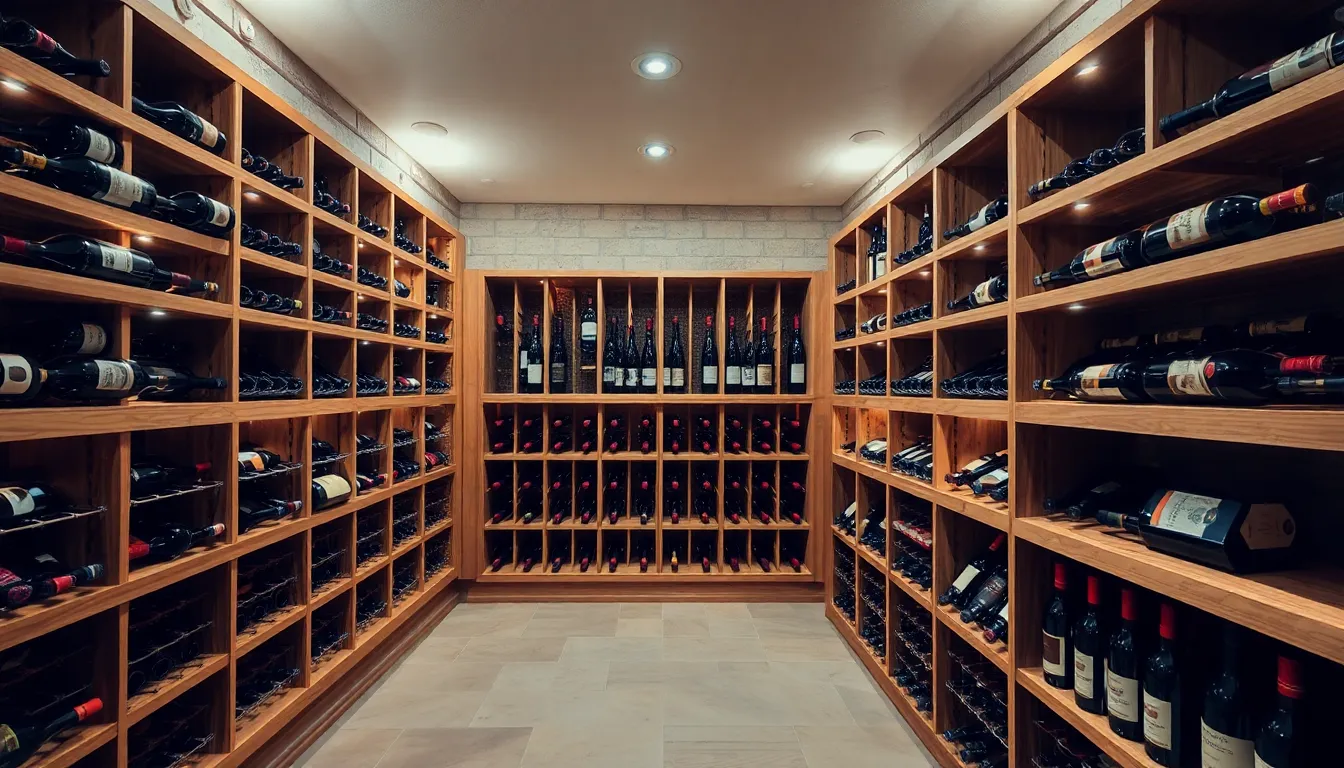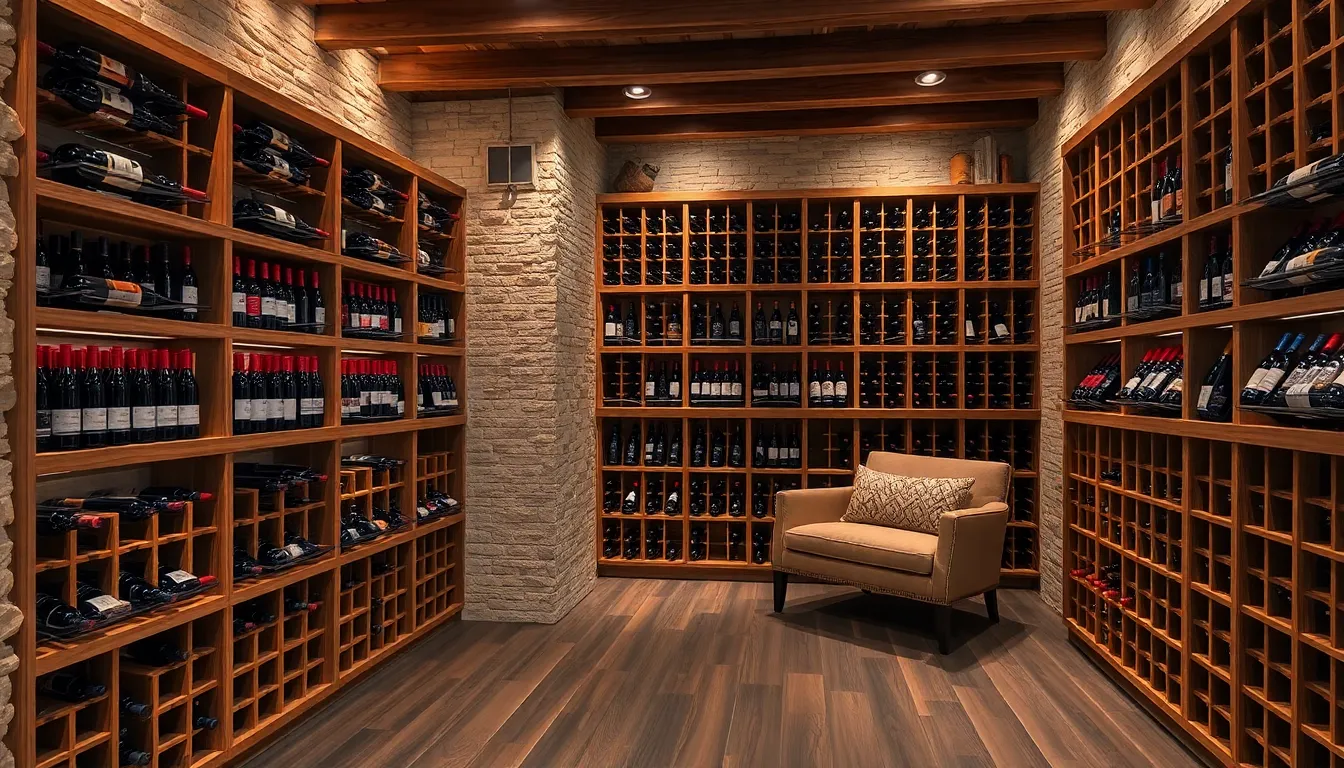Imagine stepping into a world where your wine collection is not just stored but celebrated. A well-designed wine cellar transforms that dream into reality, turning your favorite bottles into a stunning display worthy of envy. Whether you’re a casual sipper or a connoisseur with a penchant for the rarest vintages, the right design can elevate your space from mundane to magnificent.
Designing a wine cellar isn’t just about racks and bottles; it’s an art form that combines functionality with flair. Picture the perfect blend of temperature control, aesthetic appeal, and easy access, all while ensuring your wine ages gracefully. So let’s uncork the secrets of wine cellar design and dive into how to create a space that’s not only practical but also a conversation starter. After all, who wouldn’t want to impress their friends with a wine cellar that’s as fabulous as their favorite Cabernet?
Table of Contents
ToggleImportance Of Wine Cellar Design
Wine cellar design plays a crucial role in preserving wine quality. Proper organization ensures efficient access to bottles. Aesthetically pleasing designs enhance the overall ambiance of the home. Climate control measures maintain ideal temperatures and humidity levels, protecting investments.
Effective design integrates shelving that accommodates different bottle sizes. Custom racking maximizes space while providing easy visibility and access. Innovative lighting options illuminate the collection, showcasing labels and enhancing visual appeal.
Security features protect valuable collections from theft or damage. A well-thought-out layout encourages enjoyment and sharing of the wine experience. Moreover, design choices reflect personal style, blending seamlessly with existing decor.
Accessibility is vital for ease of use. Thoughtful placement of wine glasses, corkscrews, and other accessories simplifies entertaining. Additional seating areas within the wine cellar can create inviting spaces for gatherings.
Environmental considerations are increasingly important, with sustainable materials being favored in modern wine cellars. Energy-efficient climate control systems reduce environmental impact while maintaining optimal storage conditions.
Investing in a well-designed wine cellar adds value to a property. Potential homebuyers often appreciate unique features like dedicated climate-controlled storage. These aspects make wine cellar design not only practical but also financially beneficial.
Key Considerations For Designing A Wine Cellar

Designing a wine cellar involves careful attention to multiple elements essential for preserving and showcasing wine collections.
Temperature Control
Temperature influences wine quality directly. Maintaining a steady temperature between 45°F and 65°F preserves the wine’s integrity and flavors. Installing a dedicated cooling system prevents fluctuations, which can spoil wine. Some advanced systems offer digital controls for precise adjustments. Positioning the cellar away from direct sunlight also helps maintain the desired temperature. Insulated walls and doors further enhance temperature stability, making climate control a priority in cellar design.
Humidity Control
Humidity levels impact cork integrity and spoilage risk. Ideal humidity ranges from 50% to 70%, minimizing evaporation from corks. Excessive dryness leads to cork shrinkage, causing oxidation, while excessive moisture promotes mold growth. Incorporating a hygrometer allows for accurate monitoring of humidity levels. Ventilation systems or humidifiers can adjust humidity as needed. Using materials like stone or wood can naturally regulate humidity, enhancing the cellar’s environment. Planning for proper drainage and avoiding ventilation near heating sources also supports optimal humidity control.
Lighting Considerations
Lighting enhances both functionality and aesthetics in a wine cellar. Avoiding direct sunlight prevents harmful UV radiation that can degrade wine. Using low-heat LED lights offers bright visibility without warming bottles. Highlighting specific bottles with focused lighting creates an impactful display. Dimmer switches provide flexibility to adjust brightness for different occasions. The design can integrate accent lighting within shelving or racking to enhance the visual appeal of the collection. Thoughtful placement of fixtures considers both ambiance and practicality, ensuring a welcoming atmosphere for enjoyment.
Types Of Wine Cellar Designs
Wine cellars come in various designs, each catering to different tastes and preferences. Understanding these styles helps in creating a space that effectively showcases wine collections.
Traditional Wine Cellars
Traditional wine cellars often incorporate classic architectural elements. Wooden racks and natural stone walls provide a rustic charm. With dim, ambient lighting, these spaces evoke warmth and nostalgia. Often, they feature arched ceilings and handcrafted wood features that add elegance. Many designs include temperature control systems cleverly integrated to maintain optimal conditions for wine storage. Visitors appreciate the cozy atmosphere, making it an inviting setting for gatherings.
Contemporary Wine Cellars
Contemporary wine cellars prioritize clean lines and minimalistic aesthetics. Glass walls and metal accents contribute to an open and airy feel. Innovative shelving solutions present wines like art pieces, elevating their visibility. Using LED lighting enhances the modern appeal while maintaining low heat exposure. Many contemporary designs incorporate technology, such as smart cooling systems, to monitor conditions effortlessly. Homeowners often choose sleek finishes, which complement modern home decor seamlessly.
Custom Wine Cellars
Custom wine cellars offer personalized touches that reflect individual style. Each design can adapt to specific spaces and preferences, allowing for creativity in layout and functionality. Features often include custom racking options for various bottle shapes and sizes. Cohesive design elements ensure a perfect match with the rest of the home. Many homeowners opt for unique materials like reclaimed wood or custom glass displays to create a one-of-a-kind experience. Emphasizing both aesthetics and practicality, a custom wine cellar enhances any wine enthusiast’s enjoyment.
Essential Features To Include
Creating a well-designed wine cellar involves incorporating essential features that enhance both functionality and aesthetics.
Racking Systems
Custom racking systems are critical for efficient wine storage. Choose racks that accommodate various bottle sizes, ensuring easy access to each wine. Wood, metal, and acrylic are popular materials for racks, providing stability and style. Consider modular systems that allow for future expansion as the collection grows. Adding display shelves showcases special bottles, enhancing the visual appeal of the cellar.
Insulation Materials
Quality insulation materials maintain consistent temperature and humidity levels. Using spray foam or rigid foam board insulation will effectively protect the cellar from external temperature fluctuations. Walls and ceilings with proper insulation help preserve wine quality, reducing energy costs in the long run. Incorporate insulated doors that provide an additional layer of protection, ensuring a stable environment for stored bottles.
Flooring Options
Selecting the right flooring can significantly impact the overall design of a wine cellar. Opt for materials that are both durable and moisture resistant, such as tile, stone, or sealed concrete. These options enhance aesthetics while remaining practical for wine storage areas. Consider heating elements installed beneath the flooring to maintain consistent temperatures during colder months. Choose non-slip surfaces to ensure safety while navigating the cellar.
A well-designed wine cellar is more than just a storage space; it’s a celebration of wine culture and personal style. By thoughtfully integrating elements like temperature control and innovative lighting, it becomes a functional yet stunning showcase for any collection.
Investing in quality design not only preserves the integrity of the wine but also enhances the overall ambiance of the home. Whether opting for traditional charm or contemporary flair, the right choices can turn a simple cellar into a captivating experience for both the owner and their guests.
Ultimately, the journey of creating a wine cellar reflects a passion for wine and an appreciation for artistry in design.



